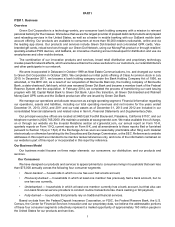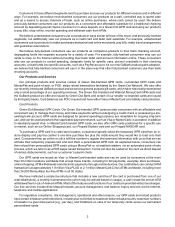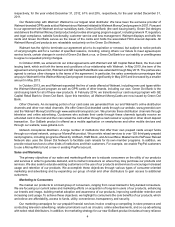Green Dot 2013 Annual Report Download - page 18
Download and view the complete annual report
Please find page 18 of the 2013 Green Dot annual report below. You can navigate through the pages in the report by either clicking on the pages listed below, or by using the keyword search tool below to find specific information within the annual report.11
In July 2013, the Federal Reserve and other U.S. banking regulators approved the final Basel III rules, which took
effect on January 1, 2014 and will be phased in over several years. Basel III continues to be subject to interpretation
by the U.S. banking regulators.
Under the regulatory framework that Congress has established and bank regulators have implemented, banks are
either “well-capitalized,” “adequately capitalized,” “undercapitalized,” “significantly undercapitalized” or “critically
undercapitalized.” Banks are generally subject to greater restrictions and supervision than bank holding companies,
and these restrictions increase as the financial condition of the bank worsens. For instance, a bank that is not well-
capitalized may not accept, renew or roll over brokered deposits without the consent of the FDIC. If our subsidiary
bank were to become less than adequately capitalized, the bank would need to submit to bank regulators a capital
restoration plan that was guaranteed by us, as its bank holding company. The bank would also likely become subject
to further restrictions on activities, such as entering into new lines of business, or would be required to conduct activities
that have the effect of limiting asset growth or preventing acquisitions. A bank that is undercapitalized would also be
prohibited from making capital distributions, including dividends, and from paying management fees to its bank holding
company if the institution would be undercapitalized after any such distribution or payment. A significantly
undercapitalized institution would be subject to mandatory capital raising activities, restrictions on interest rates paid
and transactions with affiliates, removal of management and other restrictions. The FDIC has only very limited discretion
in dealing with a critically undercapitalized institution and is virtually required to appoint a receiver or conservator.
Under these regulatory guidelines, we remain well capitalized.
Source of Strength. Under Federal Reserve Board policy, bank holding companies are expected to act as a source
of strength to their bank subsidiaries. This support may theoretically be required by the Federal Reserve Board at times
when the bank holding company might otherwise determine not to provide it. As noted above, if a bank becomes less
than adequately capitalized, it would need to submit an acceptable capital restoration plan that, in order to be acceptable,
would need to be guaranteed by the parent holding company. In the event of a bank holding company’s bankruptcy,
any commitment by the bank holding company to a federal bank regulator to maintain the capital of a subsidiary bank
would be assumed by the bankruptcy trustee and entitled to a priority of payment. In addition, under the Dodd-Frank
Wall Street Reform and Consumer Protection Act of 2010, or the Dodd-Frank Act, the Federal Reserve Board is required
to adopt new regulations formally requiring bank holding companies to serve as a source of strength to their subsidiary
depository institutions. The Federal Reserve Board has not yet proposed rules to implement this requirement.
Acquisitions of Bank Holding Companies. Under the BHC Act and the Change in Bank Control Act, and their
respective implementing regulations, Federal Reserve Board approval is necessary prior to any person or company
acquiring control of a bank or bank holding company, subject to certain exceptions. Control is conclusively presumed
to exist if an individual or company acquires 25% or more of any class of voting securities, and may be presumed to
exist if a person acquires 10% or more of any class of voting securities. These restrictions could affect the willingness
or ability of a third party to acquire control of us for so long as we are a bank holding company particularly if the third
party was not also a bank holding company.
Deposit Insurance and Deposit Insurance Assessments. Deposits accepted by banks, such as our subsidiary bank,
have the benefit of FDIC insurance up to the applicable limits. The FDIC’s Deposit Insurance Fund is funded by
assessments on insured depository institutions, the level of which depends on the risk category of an institution and
the amount of insured deposits that it holds. These rates currently range from 2.5 to 45 basis points on deposits. The
FDIC may increase or decrease the assessment rate schedule semi-annually, and has in the past required and may
in the future require banks to prepay their estimated assessments for future periods. The Dodd-Frank Act changes the
method of calculating deposit assessments, requiring the FDIC to assess premiums on the basis of assets less tangible
stockholders’ equity. The FDIC has indicated that this change will likely result in a lower assessment rate because of
the larger assessment base. Because of the current stress on the FDIC’s Deposit Insurance Fund resulting from the
banking crisis, those fees have increased and are likely to stay at a relatively high level.
Community Reinvestment Act. The Community Reinvestment Act of 1977, or CRA, and the regulations promulgated
by the FDIC to implement the CRA are intended to ensure that banks meet the credit needs of their respective service
areas, including low and moderate income communities and individuals, consistent with safe and sound banking
practices. The CRA regulations also require the banking regulatory authorities to evaluate a bank’s record in meeting
the needs of its service area when considering applications to establish new offices or consummate any merger or
acquisition transaction. The federal banking agencies are required to rate each insured institution’s performance under
the CRA and to make that information publicly available. Our subsidiary bank currently complies with the CRA through
investments and other activities that are designed to benefit the needs of low and moderate income communities.
Restrictions on Transactions with Affiliates and Insiders. Transactions between a bank and its nonbanking affiliates
are regulated by the Federal Reserve Board. These regulations limit the types and amount of these transactions,
require certain levels of collateral for loans to affiliated parties and generally require those transactions to be on an
























